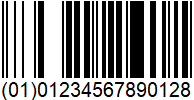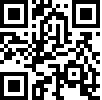Barcode Types
ABBYY FineReader Engine 12 recognizes the following types of barcodes:
| Barcode Type | Description |
|---|---|
| One-Dimensional Barcodes | |
|
|
Australia 4-State (Australia Post 4-State Customer Code) is an alphanumeric, fixed-length barcode based on the combination of 4 bars, each of which has its numerical value. The barcode symbol system supports the following alphanumeric characters: the digits (0-9), uppercase and lowercase letters (A-Z, a-z), number signs, and space characters. It is a variation of Royal Mail 4-State Customer Barcode used by Australia Post for faster automatic processing of bulk mail. |
|
|
Codabar is a self-checking, variable-length barcode that can encode 16 data characters. It is used primarily for numeric data, but also encodes six special characters. Codabar is useful for encoding dollar and mathematical figures because a decimal point, plus sign, and minus sign can be encoded. |
|
|
Code 128 is an alphanumeric, very high-density, compact, variable-length barcode schema that can encode the full 128 ASCII character set. Each character is represented by three bars and three spaces totaling 11 modules. Each bar or space is one, two, three, or four modules wide with the total number of modules representing bars an even number and the total number of modules representing a space an odd number. Three different start characters are used to select one of three character sets. |
|
|
Code 32 is a self-checking, variable-length barcode. It is a variant version of Code 39, with the characters that may be encoded limited to digits and capital letters excluding the vowels ('A', 'E', 'I', 'O', 'U'). It is used in Italian medication packaging and is also known as Italian Pharmacode. |
|
|
Code 39, also referred to as Code 3 of 9, is an alphanumeric, self-checking, variable-length barcode that uses five black bars and four spaces to define a character. Three of the elements are wide and six are narrow. Code 39 character set includes uppercase A-Z, the digits 0-9, several special marks ( $ % + - . / ), and the space character. |
|
|
Code 93 is a variable-length barcode that encodes 47 characters. It is named Code 93 because every character is constructed from nine elements arranged into three bars with their adjacent spaces. Code 93 is a compressed version of Code 39 and was designed to complement Code 39. |
|
|
The European Article Numbering (EAN) system is used for products that require a country's origin. This is a fixed-length barcode used to encode either eight or thirteen characters. The first two characters identify the country of origin, the next characters are data characters, and the last character is the checksum. These barcodes may include an additional barcode to the right of the main barcode. This second barcode, which is usually not as tall as the primary barcode, is used to encode additional information for newspapers, books, and other periodicals. The supplemental barcode may either encoded 2 or 5 digits of information. |
|
|
This is an extended version of Code 39. It is used to encode all 128 ASCII characters by using pairs of Code 39 characters to represent the lowercase ASCII characters not in the Code 39 character set. |
|
|
GS1-128 is a variable-length barcode that is used to encode 128 ASCII characters. It is a universal barcode for retail product marking or shipping and may encode quantities, weight, price (and much more data) of the product. Formerly called UCC-128. |
|
|
IATA 2 of 5 is a self-checking, variable-length barcode designed by the IATA (International Air Transport Association). This standard is used for all boarding passes. The code may include a checksum. |
|
|
Industrial 2 of 5 is a numeric-only barcode that has been in use for a long time. Unlike Interleaved 2 of 5, all of the information is encoded in the bars. The spaces are fixed-width and are used only to separate the bars. The code is self-checking and may include a checksum. |
|
|
Intelligent Mail is a height-modulated 65-bar barcode that is used to sort letters and tracks in the United States. It also includes a checksum for verifying the barcode value. It is also known as USPS 4-CB. |
|
|
Interleaved 2 of 5 is a variable-length (must be a multiple of two), high-density, self-checking, numeric barcode that uses five black bars and five white bars to define a character. Two digits are encoded in every character; one in the black bars and one in the white bars. Two of the black bars and two of the white bars are wide. The other bars are narrow. The code does not include a checksum. |
|
|
Japan Post (Japanese Post 4-state Customer Code) is an alphanumeric, fixed-length barcode using data characters to encode a 7-digit postal code and address of up to 13 alphanumeric characters. The Japan Post barcode allows for letters (A-Z), digits (0-9), and hyphens (-). Sometimes Japanese addresses have the hyphen between the postal code and the address data, or a postal code itself contains the hyphen; in these cases, the hyphen does not appear in the encoded data. Nevertheless, the remaining hyphens are encoded. Japanese postal system uses these barcodes for automated mail sorting. |
|
|
KIX (KIX 4-State Customer Code) is an alphanumeric, variable-length barcode that uses the data characters made up of 4 separate bars. KIX character set includes uppercase letters (A-Z) and digits (0-9). It is a version of Royal Mail 4-State Customer Barcode that lacks the start and stop bars or the checksum. KIX is used by the Netherlands postal system for the sorting of mail items. |
|
|
Standard 2 of 5 is a self-checking numeric-only barcode. Unlike Interleaved 2 of 5, all of the information is encoded in the bars. The spaces are fixed-width and are used only to separate the bars. Matrix 2 of 5 is used primarily for warehouse sorting, photo finishing, and airline ticket marking. The code may include a checksum. |
|
|
A pattern of horizontal black bars separated by spaces. Typically, a patch code is placed near the top center of a paper document to be scanned and used as a document separator. |
|
|
The Postnet (Postal Numeric Encoding Technique) is a fixed-length symbology (5, 6, 9, or 11 characters) that uses constant bar and space width. Information is encoded by varying the bar height between the two values. Postnet barcodes are placed on the lower right of envelopes or postcards and are used to expedite the processing of mail with automatic equipment and provide reduced postage rates. |
|
|
Royal Mail 4-State (Royal Mail 4-State Customer Barcode) is an alphanumeric, fixed-length barcode that uses special data characters for encoding information. Each character is made up of 4 bars, 2 of which extend upward, and 2 of which extend downward. The combination of the top and bottom halves gives 36 possible symbols: 10 digits and 26 letters. Royal Mail uses these barcodes for faster automated mail sorting. |
|
|
The UPC-A (Universal Product Code) barcode is 12 digits long, including its checksum. Each digit is represented by a seven-bit sequence, encoded by a series of alternating bars and spaces. UPC-A is used for marking products that are sold at retail in the USA. |
|
|
The UPC-E barcode is a shortened version of the UPC-A barcode that can display digits from 0 to 9. It has eight digits, including a checksum, and begins with 0 or 1. The UPC-E barcode is a compressed barcode intended for use on small items. |
| Two-Dimensional Barcodes | |
|
|
Aztec is a high-density matrix style barcode symbology that can encode up to 3832 digits, 3067 alphanumeric characters, or 1914 bytes of data. The symbol is built on a square grid with a bulls-eye pattern at its center. The symbol size adjusts automatically depending on the amount of input data. Aztec can encode from small to large amounts of data with user-selected percentages of error correction. |
|
|
Data Matrix is a matrix barcode consisting of black and white modules arranged in either a square or rectangular pattern. Every Data Matrix is composed of two solid adjacent borders in an "L" shape and two other borders consisting of alternating dark and light modules. Within these borders are rows and columns of cells encoding information. A Data Matrix barcode can store up to 2335 alphanumeric or 3116 numeric characters. |
|
|
MaxiCode is a fixed-size code. It is a 1-inch square, which has a bull's eye finder pattern in the middle, surrounded by dots arranged in hexagonal grid. A single MaxiCode symbol can store up to 138 digits or 93 alphanumeric characters, and up to 8 MaxiCode symbols can be chained together. This barcode is used on packing slips for package sorting and addressing worldwide. |
|
|
PDF417 is a variable-length, stacked symbology that can store up to 2725 digits, 1850 printable ASCII characters or 1108 binary characters per symbol. PDF417 is designed with selectable levels of error correction. Its high data capacity can be helpful in applications where a large amount of data must travel with a labeled document or item. |
|
|
QR Code is a matrix barcode with 3 large squares (registration marks) in the corners which define the top of the barcode. The black and white squares in the area between the registration marks are the encoded data and error correction keys. QR Codes can encode not only over 4000 ASCII characters but Kana, binary, and Kanji characters too. They also support Structured Append mode, in which up to 16 codes can be linked logically together to encode a large amount of data. |
See also
11/7/2025 12:48:30 PM

























